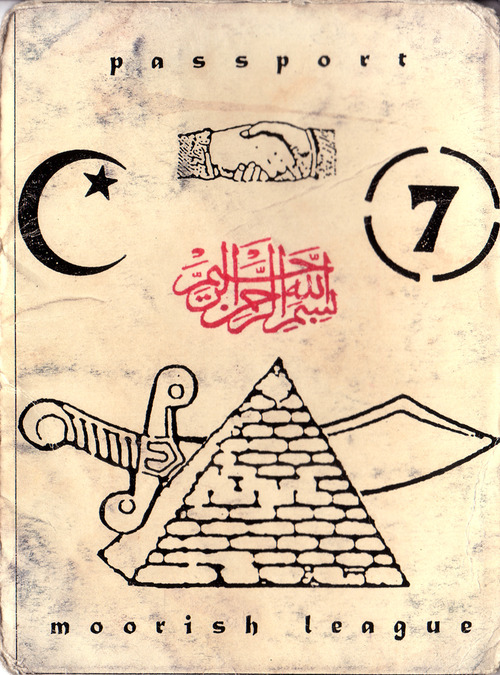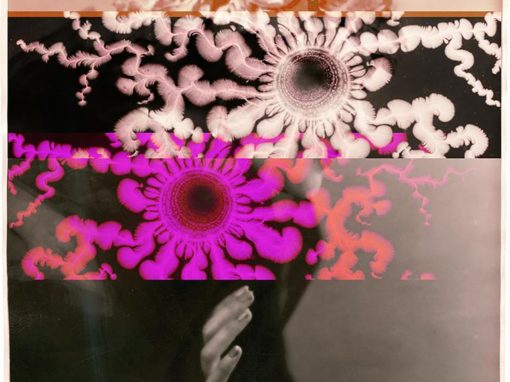Affiliated with counter-cult folks like Hakim Bey / PLW and James Koehnline, MOC was a little-known psychedelic & radical, quasi-mail art network of the 80s, through into maybe the 2000s.

(The whole thing goes back to Timothy Drew / Noble Drew Ali, a Black occultist from the turn of the last century, who may have travelled around North Africa, hung out with dervishes, sampled hashish and other unguents of the mind. We only mention because the gloss below doesn’t recount that earlier history…)
This group is said to have been a spinoff of one of the Moorish Science Temples in Baltimore (!), sometime in the late 50s.
A scholarly researcher has started to log some of these long obscure ‘material culture’ items online, old BAI radio shows coming next…. love the passport, by the way, …
“This diminutive church emerged in the first half of the 1960s on the Upper West Side of New York City, and before long, its members became embedded in the network of religious fellowships, esoteric sects, and street crews that populated the larger New York City bohemian scene. This psychedelic enclave provided fertile ground for the Moorish Orthodox Church of America (henceforth MOCA), which soon produced its own publications, and radio shows. It also operated its own temple/head-shop (known as The Crypt) on W. 103rd street. In addition to focusing on their own spiritual self-cultivation, members also doubled as “righteous dealers” who dispensed the “sacrament” of LSD to their brothers & sisters. The church worked alongside dozens of other heterodox mystical sects, as well as an army of psychedelic evangelists, to seed wide-spread spiritual illumination, and their combined efforts produced an exuberant culture of religious experimentation that soon spread across America, and points beyond.
“The rise and fall of the psychedelic movement of the 1960s has been documented by historians and commentators alike. There is far less research on the persistence of this rebellious enthusiasm into the 1970s, 80s, and 90s. This site will attempt to address this lacuna by compiling the primary source documents from MOCA throughout the last fifty years.
“The present archival project emerges out of my PhD research. Entitled Angelheaded Hipsters: Psychedelic Militancy in Nineteen-Eighties North America, my dissertation focuses on the marginalized religious actors and underground churches that evangelized the power of mind-expanding, or “entheogenic” substances. The pioneering psychedelic sects of the 1960s, specifically Timothy Leary’s League of Spiritual Discovery, Ken Kesey’s Merry Pranksters, and the Brotherhood of Eternal Love, provided a basis for an underground of ludic spiritual non-conformity that flourished in the 1980s and 1990s. The revival of the psychedelic worldview in the decades leading up to the millennium was led by members of the Discordian Society, The Church of the SubGenius, as well as a revitalized Moorish Orthodox Church of America.”
“…these outlaw churches disseminated their ideas in DIY (“Do it Yourself”) media including mimeographed journals, xerographical chap books, ordination certificates, artist stamps, membership cards, “zines” (short for “fanzine”), VHS recordings, mail-art, cassette tapes/anti-music, posters, and ceremonial regalia. The material history of this underground culture of religious non-conformity is vast, and largely undocumented. (The notable exception in this regard would be Adam Gorightly’s Historia Discordia.) Here, you will find a growing archive of material related to the militant psychedelicist vangard that arose in the medium of zines. At present, the site hosts written and audio recordings from the MOCA; however, there are plans to expand it to include other fanzines related to other psychedelicist churches of the era. Here, I would like to note how especially proud I am to offer the supposedly lost recordings of the Moorish Orthodox Radio Crusade show, which aired on the non-commercial radio station WBAI in New York City from 1987-2012. These recordings are essential to understanding the antinomian underground of the 1980s and 1990s, and it was only by a stroke of great fortune that I was able to locate many of the original cassette recordings.”
http://morcarchive.squarespace.com/
Related, check out the Digger Archive, also the White Panther/JohnSinclair feed on IG.




